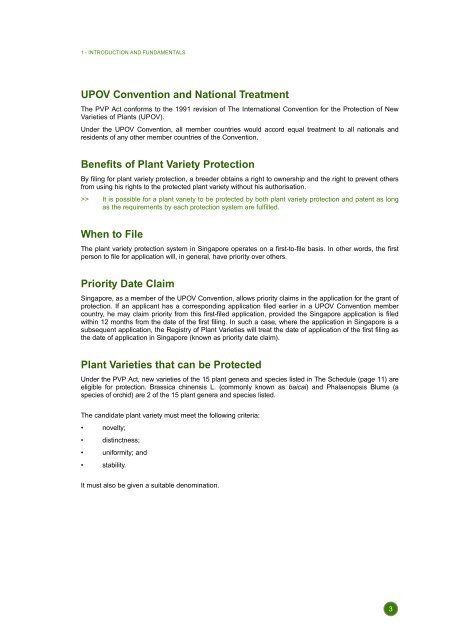Plant Varieties Protection Infopack - Intellectual Property Office of ...
Plant Varieties Protection Infopack - Intellectual Property Office of ... Plant Varieties Protection Infopack - Intellectual Property Office of ...
1 - INTRODUCTION AND FUNDAMENTALSUPOV Convention and National TreatmentThe PVP Act conforms to the 1991 revision of The International Convention for the Protection of NewVarieties of Plants (UPOV).Under the UPOV Convention, all member countries would accord equal treatment to all nationals andresidents of any other member countries of the Convention.Benefits of Plant Variety ProtectionBy filing for plant variety protection, a breeder obtains a right to ownership and the right to prevent othersfrom using his rights to the protected plant variety without his authorisation.>> It is possible for a plant variety to be protected by both plant variety protection and patent as longas the requirements by each protection system are fulfilled.When to FileThe plant variety protection system in Singapore operates on a first-to-file basis. In other words, the firstperson to file for application will, in general, have priority over others.Priority Date ClaimSingapore, as a member of the UPOV Convention, allows priority claims in the application for the grant ofprotection. If an applicant has a corresponding application filed earlier in a UPOV Convention membercountry, he may claim priority from this first-filed application, provided the Singapore application is filedwithin 12 months from the date of the first filing. In such a case, where the application in Singapore is asubsequent application, the Registry of Plant Varieties will treat the date of application of the first filing asthe date of application in Singapore (known as priority date claim).Plant Varieties that can be ProtectedUnder the PVP Act, new varieties of the 15 plant genera and species listed in The Schedule (page 11) areeligible for protection. Brassica chinensis L. (commonly known as baicai) and Phalaenopsis Blume (aspecies of orchid) are 2 of the 15 plant genera and species listed.The candidate plant variety must meet the following criteria:• novelty;• distinctness;• uniformity; and• stability.It must also be given a suitable denomination.3
1 - INTRODUCTION AND FUNDAMENTALSNoveltyDistinctnessUniformityThe variety has not been sold or disposed of, by or with the consent of the breederi) earlier than 1 year before the date of application in Singapore where thesale or disposal is made in Singapore; andii)where the sale or disposal is made outside of Singapore, earlier than 6 yearsbefore the date of application in the case of trees or vines, or earlier than 4years before the date of application in the case of other plant varieties.The variety is clearly distinguishable from any other variety whose existence is amatter of common knowledge at the time of filing of the application. A variety thatis of common knowledge does not have to be a protected variety.The variety is sufficiently uniform in its relevant characteristics, subject to thevariation that may be expected from the particular features of its propagation.StabilityThe relevant characteristics of the variety remain unchanged after repeatedpropagation or, in the case of a particular cycle of propagation, at the end of eachsuch cycle.>> The distinctness, uniformity and stability (DUS) criteria are often grouped and examined together,and referred to as the "DUS Test”. The candidate variety will undergo a DUS Test conducted duringthe technical examination to ensure conformance.DenominationA denomination is the distinguishing name or identification for the plant variety.The breeder of the new variety has to propose a suitable denomination as its genericdesignation for approval. An example, “Summer Snow” is a denomination underRosa in a particular UPOV Convention member country.>> To conduct a search on the denominations in the UPOV Register, any member of the public mayaccess the records at the IPOS Public Search Room.4
- Page 3: Copyright © 2012 Intellectual Prop
- Page 8 and 9: 1 - INTRODUCTION AND FUNDAMENTALSTh
- Page 10 and 11: 3 APPLICATION PROCESSFiling an Appl
- Page 12 and 13: 3 - APPLICATION PROCESSDate of Fili
- Page 14 and 15: List of Genera and Species - The Sc
- Page 16 and 17: The Intellectual Property Office of
1 - INTRODUCTION AND FUNDAMENTALSUPOV Convention and National TreatmentThe PVP Act conforms to the 1991 revision <strong>of</strong> The International Convention for the <strong>Protection</strong> <strong>of</strong> New<strong>Varieties</strong> <strong>of</strong> <strong>Plant</strong>s (UPOV).Under the UPOV Convention, all member countries would accord equal treatment to all nationals andresidents <strong>of</strong> any other member countries <strong>of</strong> the Convention.Benefits <strong>of</strong> <strong>Plant</strong> Variety <strong>Protection</strong>By filing for plant variety protection, a breeder obtains a right to ownership and the right to prevent othersfrom using his rights to the protected plant variety without his authorisation.>> It is possible for a plant variety to be protected by both plant variety protection and patent as longas the requirements by each protection system are fulfilled.When to FileThe plant variety protection system in Singapore operates on a first-to-file basis. In other words, the firstperson to file for application will, in general, have priority over others.Priority Date ClaimSingapore, as a member <strong>of</strong> the UPOV Convention, allows priority claims in the application for the grant <strong>of</strong>protection. If an applicant has a corresponding application filed earlier in a UPOV Convention membercountry, he may claim priority from this first-filed application, provided the Singapore application is filedwithin 12 months from the date <strong>of</strong> the first filing. In such a case, where the application in Singapore is asubsequent application, the Registry <strong>of</strong> <strong>Plant</strong> <strong>Varieties</strong> will treat the date <strong>of</strong> application <strong>of</strong> the first filing asthe date <strong>of</strong> application in Singapore (known as priority date claim).<strong>Plant</strong> <strong>Varieties</strong> that can be ProtectedUnder the PVP Act, new varieties <strong>of</strong> the 15 plant genera and species listed in The Schedule (page 11) areeligible for protection. Brassica chinensis L. (commonly known as baicai) and Phalaenopsis Blume (aspecies <strong>of</strong> orchid) are 2 <strong>of</strong> the 15 plant genera and species listed.The candidate plant variety must meet the following criteria:• novelty;• distinctness;• uniformity; and• stability.It must also be given a suitable denomination.3



